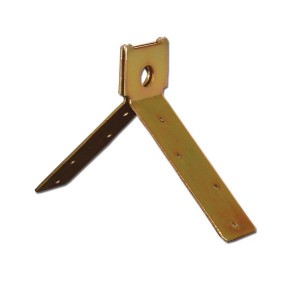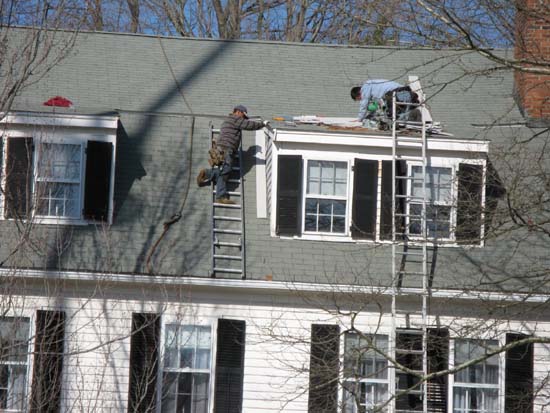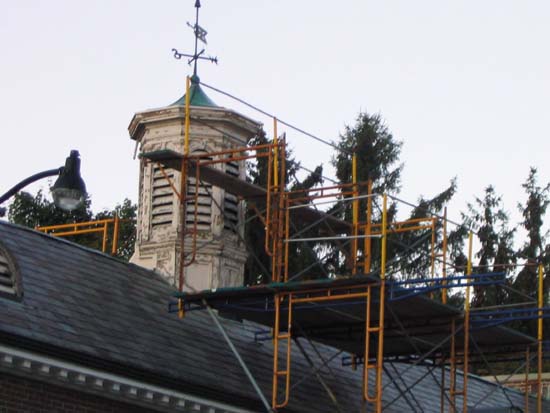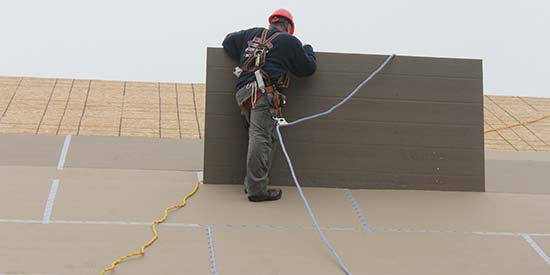Fall Protection – OSHA Guideline for Residential Construction
Fall Protection Systems for OSHA compliant Residential Construction
If you’ve ever worked on a roof, scaffolding, or pump jacks 2 or 3 stories high you know it can be a bit frightening. But like we often do in the construction industry, we grin and bare it, never complaining, never admitting our fear or vulnerability.
But the reality of our situation is that falls are the leading cause of deaths on construction sites. And as Dr. David Michaels, Assistant Secretary of Labor for OSHA, stated “We cannot tolerate workers getting killed in residential construction when effective means are readily available to prevent those deaths.” Instead of working like the guys in the photo above we’ll discuss how to work more safely on residential jobsites.
Failure to meet OSHA Regulations can result in stoppage of work, citations, and worst of all a needless death of one of your employees. This article will lay out the current OSHA requirements, pulled directly from OSHA guidance, basic overview of the Conventional Fall Protection Systems, including an in depth look at Personal Fall Arrest Equipment.
OSHA Regulations and Requirements
“Effective June 16, 2011 employers utilizing alternative fall protection found in the rescinded 1999 Interim Fall Protection Compliance Guidelines for Residential Construction will be subject to OSHA citations if they fail to comply with 29 CFR 1926.501(b)(13).”
1926.501(b)(13) states… workers “engaged in residential construction activities 6 feet (1.8 m) or more above lower levels shall be protected by guardrail systems, safety net system, or personal fall arrest system.”
Although conditions do exist for alternative measures to be used when fall protection methods listed above. Specifically, when conventional fall protection is infeasible or creates a greater hazard to workers.
Alternative fall protection measures allowed under 1926.501(b) for particular types of work are as follows.
- Controlled Access Zones
- Control Lines
- Covers
- Positioning Devices
- Barricades, Fences, and Covers
- Equipment Guards
- Warning Line and Safety Monitoring System
Despite the flexibility of the new OSHA regulations, the agency does not find “economic in-feasibility” to be a valid excuse for failure to use conventional fall protection. Furthermore OSHA expects fall protection methods listed in 1926.501(b)(13) can be used without significant safety of feasibility problems for the vast majority of residential construction activities.
Bottom Line: These new requirements are the new normal, so you and your crews need to get on board. We’ll show you how!
Proper System Setup
Conventional Fall Protection Systems include Guardrail, Safety Net, and Personal Fall Arrest Systems. We’ll lay out the basic OSHA requirements for each and explore the successful use and implementation of Personal Fall Arrest Equipment.
Guardrail Requirements: A Guardrail will be used above lower levels exceeding 6 feet high. Guardrails will consist of a Top Rail at 42 inches (+/- 3 inches) that can withstand up to 200 pounds and a Mid-Rail halfway between Top Rail and standing surface which can withstand up to 150 pounds. The surface of the rail should be free of steel and/or plastic banding and surfaced to prevent punctures, lacerations, and snagging of clothing.
Safety Net Requirements: Safety Nets will be placed as close as practicable, no more than 30 feet below protected surface, with sufficient clearance to prevent contact with surface or structures below. Safety nets need to be drop tested or certified.
For minimum required horizontal distance of outer edge of net from edge of working surface based on vertical distance from working level to horizontal plane of net see table 1926.502(c)(2).
Personal Fall Arrest System Requirements: Also known as PFAS must include these three components: Anchor, Harness, and Lanyard. A PFAS may also feature a deceleration line or lifeline. An Anchor must be able to support at least 5,000 pounds per employee linked to the anchor point. Employers should follow manufacturer’s instructions on proper installation or seek the recommendation of a registered professional engineer.
Personal Fall Arrest System (PFAS) Equipment and Implementation
First and foremost I recommend that at least one member of your crew participate in an advanced Fall Protection course to oversee the execution of fall protection measures, ensures your crew follows OSHA guidance, and uses PFAS equipment properly. This crew member becomes an advocate for your crew’s safety and protects you from overlooking a fall protection deficiency that could result in stoppage of work, citations, or harm to your employees.
Before you employ a PFAS on your job-site be sure you have at least one member trained on the proper use and considerations of Fall Arrest equipment. Have your crew participate in a group orientation/training session to introduce them to the equipment and how it works. Basic considerations of PFAS equipment include:
- Employees should understand they must wear a FULL body harness, body belts are no longer permitted
- Harnesses should be sized properly and fit snug to the Shoulders, Chest, Waist, Pelvis, and Thighs
 The only approved attachment point of the Full Body Harness is on the D-Ring located on the back of the harness
The only approved attachment point of the Full Body Harness is on the D-Ring located on the back of the harness- D-Ring must sit high on the users back between the shoulder blades
- Lanyard snaphooks used MUST be locking per 1926.502(d)(5)
- PFAS anchors should be installed per the manufacturer instructions
- Calculate the appropriate Fall distance for each employee at each level before PFAS is set up
- Be sure to include the additional distance you may fall with a Deceleration Device (3-1/2 feet)
Overview
It is your responsibility as the leader of your crew to ensure their safety and the OSHA guidelines regarding fall protection exist for the benefit of both you and your employees. Always refer to OSHA regulations and guidance for proper fall protection requirements and approved methods. Utilizing PFAS can be easier than you think and can give you and your crew the peace of mind while working at high elevations.

















Another thing to note is that so many people use the safety systems in the wrong manner. The attachment point to structure is below them so if they fall they end up falling almost double the length of line they have out.
Good inclusion of Rob’s cupola picture. On a job like that taking time to set up effective and safe staging helps workers to work faster.